鲁教版六年级英语下册Unit 6 Don't eat in class. Section A Part Two(3a-3c)课件(共32张PPT,无音频)
文档属性
| 名称 | 鲁教版六年级英语下册Unit 6 Don't eat in class. Section A Part Two(3a-3c)课件(共32张PPT,无音频) |
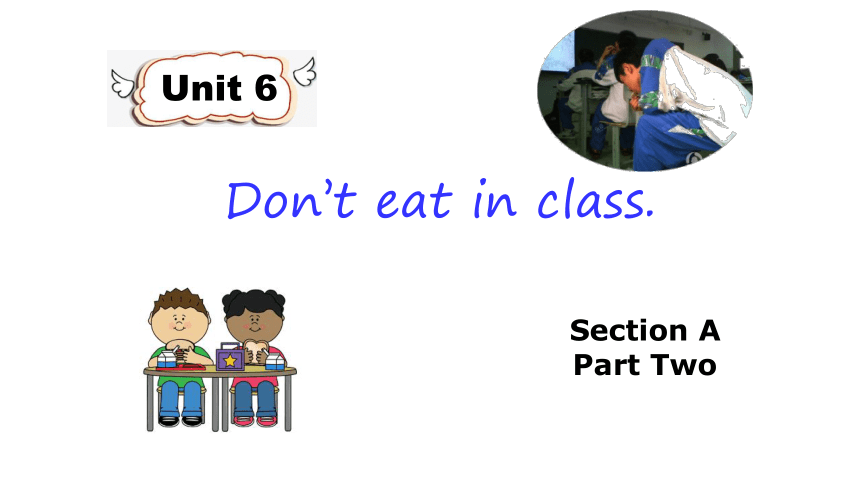
|
|
| 格式 | zip | ||
| 文件大小 | 2.7MB | ||
| 资源类型 | 教案 | ||
| 版本资源 | 鲁教版 | ||
| 科目 | 英语 | ||
| 更新时间 | 2020-04-06 09:47:20 | ||
图片预览

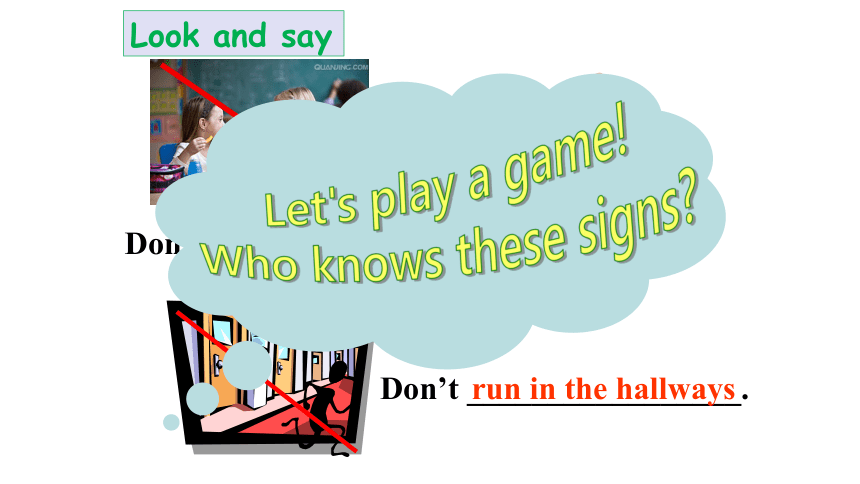

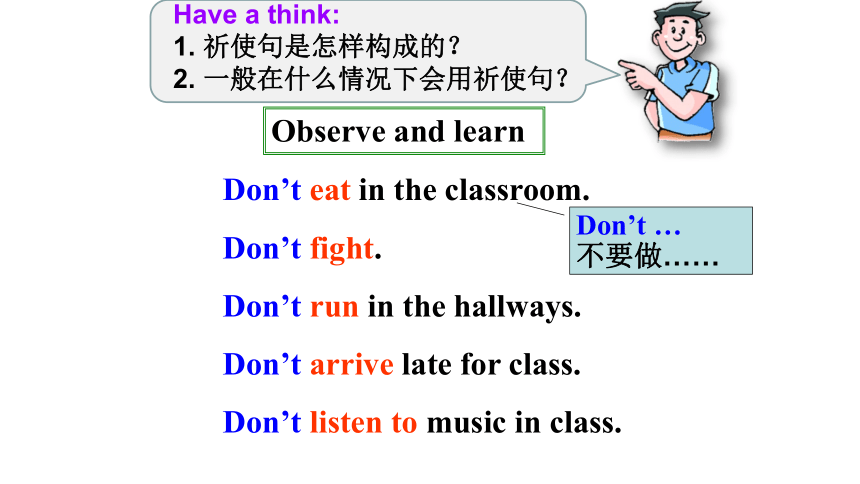
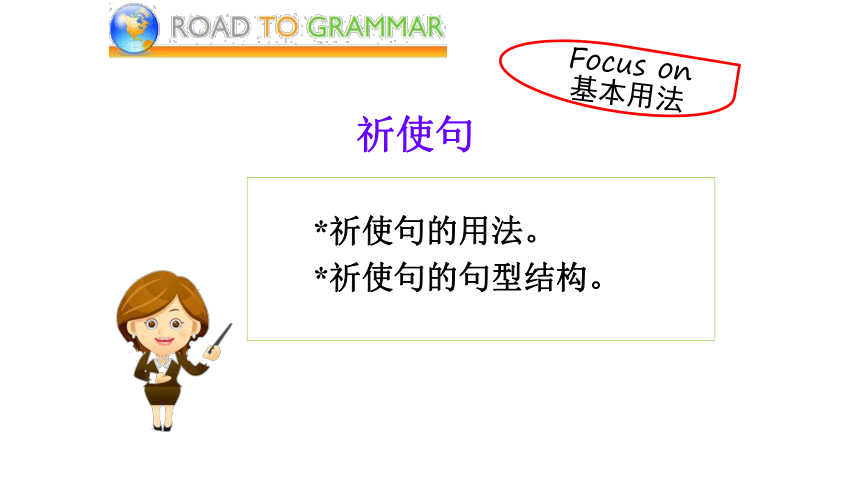
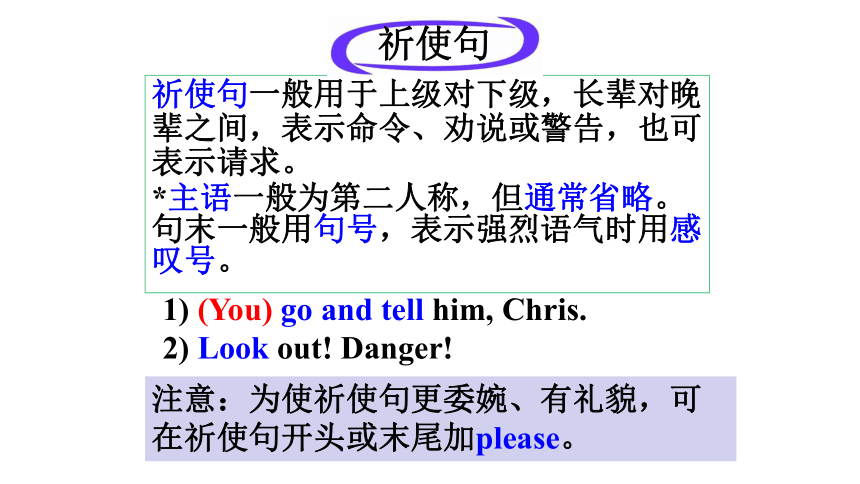
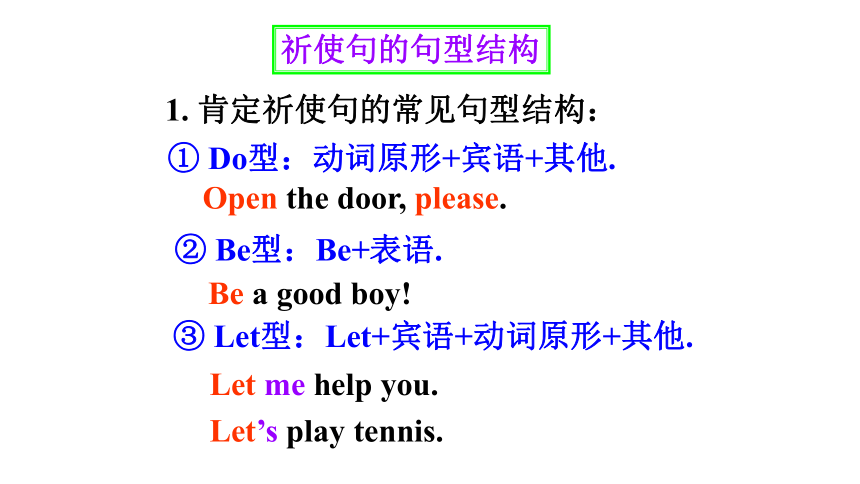
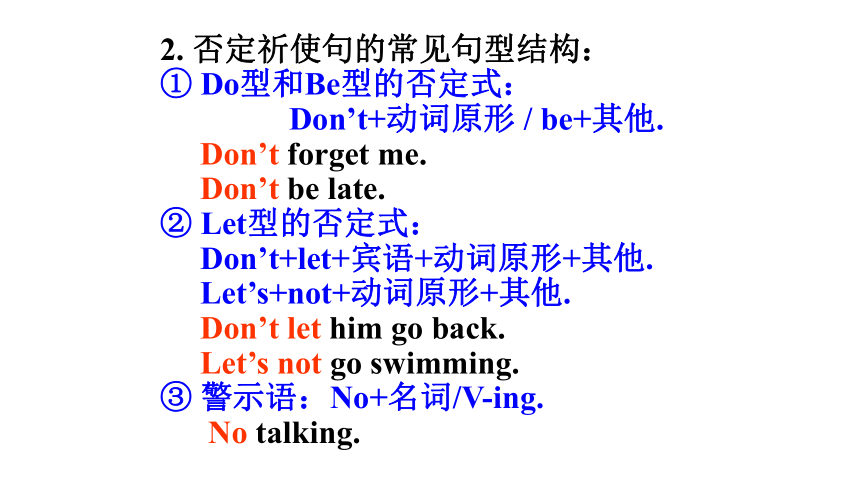
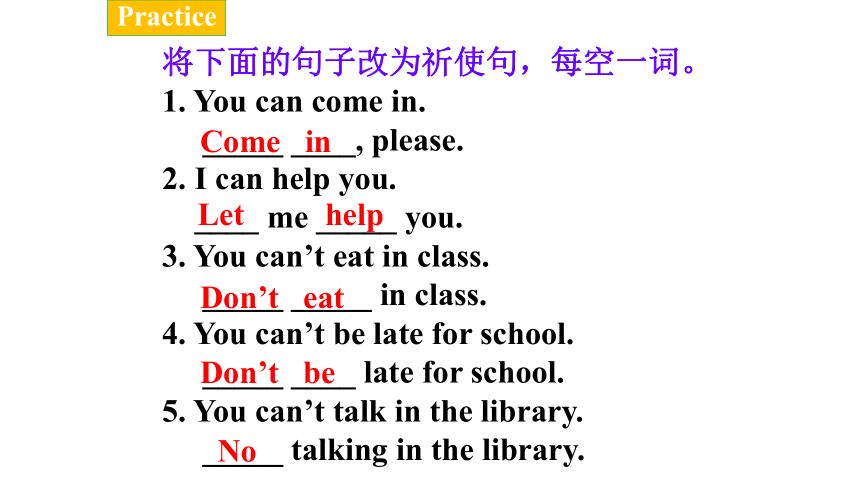
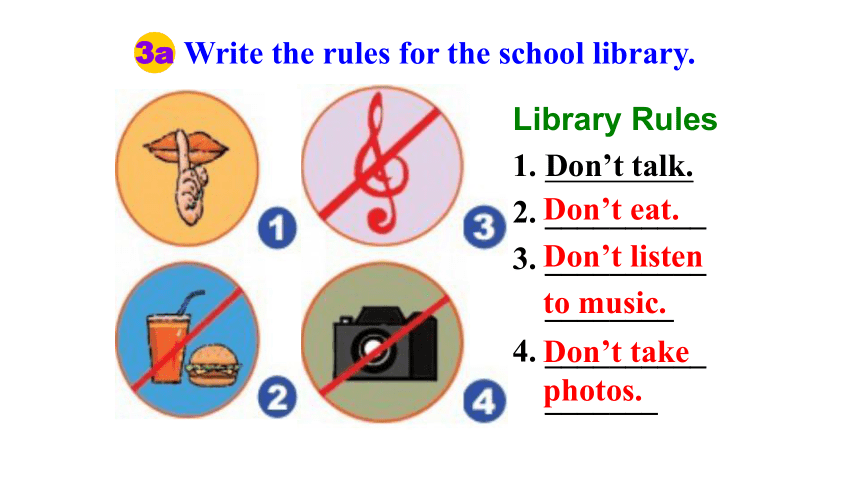
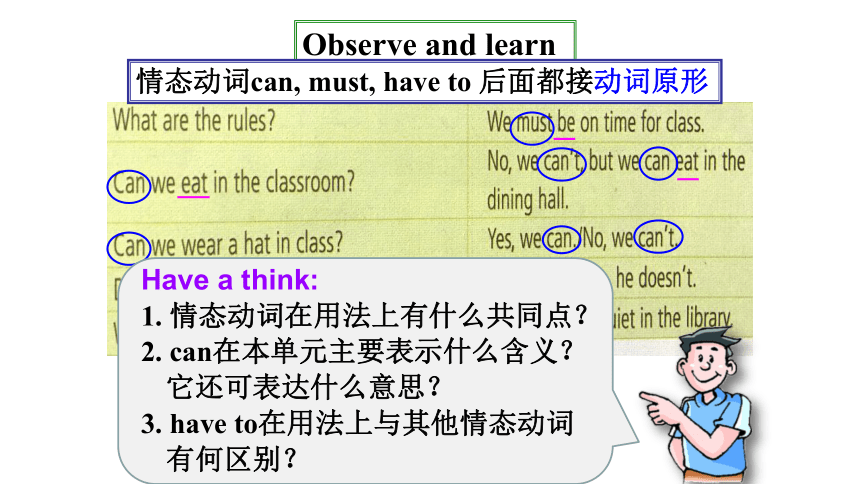

文档简介
(共32张PPT)
Don’t eat in class.
Section A
Part Two
Don’t ________________!
Look and say
Don’t _____.
fight
Don’t _________________.
run in the hallways
eat in the classroom
Don’t _____________ class.
arrive late for
Don’t ____________
_______!
listen to music
in class
Observe and learn
Don’t eat in the classroom.
Don’t fight.
Don’t run in the hallways.
Don’t arrive late for class.
Don’t listen to music in class.
Don’t …
不要做……
Have a think:
1. 祈使句是怎样构成的?
2. 一般在什么情况下会用祈使句?
祈使句
Focus on
基本用法
*祈使句的用法。
*祈使句的句型结构。
祈使句一般用于上级对下级,长辈对晚辈之间,表示命令、劝说或警告,也可表示请求。
*主语一般为第二人称,但通常省略。句末一般用句号,表示强烈语气时用感叹号。
1) (You) go and tell him, Chris.?
2) Look out! Danger!?
注意:为使祈使句更委婉、有礼貌,可在祈使句开头或末尾加please。
1. 肯定祈使句的常见句型结构:
祈使句的句型结构
Let me help you.
Let’s play tennis.
Be a good boy!
Open the door, please.
③ Let型:Let+宾语+动词原形+其他.
② Be型:Be+表语.
① Do型:动词原形+宾语+其他.
2. 否定祈使句的常见句型结构:
① Do型和Be型的否定式:
Don’t+动词原形 / be+其他.
Don’t forget me.
Don’t be late.
② Let型的否定式:
Don’t+let+宾语+动词原形+其他.
Let’s+not+动词原形+其他.
Don’t let him go back.
Let’s not go swimming.
③ 警示语:No+名词/V-ing.
No talking.
将下面的句子改为祈使句,每空一词。
1. You can come in.
_____ ____, please.
2. I can help you.
____ me _____ you.
3. You can’t eat in class.
_____ _____ in class.
4. You can’t be late for school.
_____ ____ late for school.
5. You can’t talk in the library.
_____ talking in the library.
Come in
Let help
Don’t eat
Don’t be
No
Practice
Library Rules
1. Don’t talk.
2. __________
3. __________
________
4. __________
_______
Don’t eat.
Write the rules for the school library.
Don’t listen to music.
Don’t take photos.
3a
Observe and learn
Have a think:
1. 情态动词在用法上有什么共同点?
2. can在本单元主要表示什么含义?它还可表达什么意思?
3. have to在用法上与其他情态动词有何区别?
情态动词can, must, have to 后面都接动词原形
情态动词can, must & have to
Focus on
基本用法
*情态动词must的用法及句型结构;
*情态动词have to的用法及句型结构。
*情态动词can的用法及句型结构;
1. 本单元中can 意为“可以”,表示请求、允许。
I?can?dance?and?sing.
情态动词 can
2. Can还可表示能力,意为“能,会”。
1) -Can?the?students?run?in?the?hallways??
-Yes, they can./No, they can’t.
2) We can’t eat in the classroom.?
情态动词can的句型结构:
1) I?can?dance?and?sing.
2) We can’t eat in the classroom.
3) -Can?the?students?run?in?the?hallways??
-Yes, they can.
No, they can’t.?
肯定: 主语+can+V原形+其他.
否定:主语+can not/can’t+V原形+其他.
疑问句: Can+主语+V原形+其他?
肯定回答:Yes, 主语+can.
否定回答:No, 主语+can’t.
情态动词must表说话人的主观看法,表示必须、必要。无人称和数的变化 ,不能单独使用,必须与其后的动词原形构成谓语。
情态动词must
1) You must come in time.
你必须按时来。
2) I must get some sleep.
我必须睡会儿觉了。
句型结构:主语+must+V原形+其他.
must的句型结构:
1. Everyone must obey the rule.
2. You mustn’t speak like that.
3. - Must I be home before 8 o’clock?
-Yes, you must.
-No, you needn’t./No, you don’t have to.
肯定:主语+must+V原形+其他.
否定:主语+mustn’t/must not+V原形+其他.
疑问句: Must+主语+V原形+其他?
肯定回答: Yes, 主语+must.
否定回答: No, 主语+needn’t/don’t have to.
must not表示“不应该”、“禁止”、“不准”。语气比较强烈。
情态动词have to
have to 表示必须,强调客观需要,有不得不、被逼无奈做某事的意思。
它既有人称、单复数的变化、也有动词时态的变化。
其否定形式和疑问句形式均需要借助助动词do才可以进行变化。
have to的句型结构:
1. She has to look after her mother at home.
2. We don’t have to clean the room today.
3. -Does he have to go to bed now?
-Yes, he does.
-No, he doesn’t.
肯定:主语+have/has/had?to+V原形+其他
否定:主语+don’t/doesn’t/didn’t?have?to+V原形+其他
疑问句: Do/Does/Did+主语+have?to+V原形+其他?
肯定回答:Yes, 主语+do/does/did.
否定回答:No, 主语+don’t/doesn’t/didn’t.
must通常表示说话人的主观看法,语气比较强烈,have to 往往强调客观需要。
表示“必须”,有时二者可互换。
We have to/must follow the rules.
它们的否定式含义大不相同。mustn’t表示“不准;禁止”,don’t have to表示“不必”。
*I must go now.
*It’s a little late and I have to go now.
*You mustn’t talk to your mother like that.
*You don’t have to come if you don’t want to.
must一般只表示现在,没有人称和数的变化。
而have to则可以用于不同的时态,有人称和数的变化。
*You mustn’t talk to your mother like that.
*You don’t have to come if you don’t want to.
相同点
不同点
There is nothing in the fridge. I?________ go shopping now.?
It’s very warm. You?______________ (不必)?wear the coat.??
have to
don’t have to
根据所给提示用must, have to, can的恰当形式填空。
Practice
-_____ we wear hats in school?
-Yes, we can.
Can
We _______ protect our environment.
must
Use the words to make questions about the rules. Then write answers according to your school.
3b
1. Be quite?
Q: ___________________________________
(she/have to/in the library)
A: ____________
2. Eat?
Q: ____________________________
(he/have to/in the dining hall)?
A: ________________________
3. Listen to music?
Q: _______________(we/can/in the hallways)?
A: ________________
4. Wear a hat?
Q: _______________ (we/can/in the classroom)?
A: _______________
Does she have to be quite in the library?
Yes, she does.
2. Eat?
Q: ________________________________
(he/ have to/ in the dining hall)?
A: _____________________
3. Listen to music?
Q: ________________________________
(we/ can/ in the hallways)?
A: ________________
4. Wear a hat?
Q: _______________________________
(we/ can/ in the classroom)?
A: _______________
Can we listen to music in the hallways?
Can we wear a hat in the classroom?
No, we can’t.
No, we can’t.
Does he have to eat in the dining hall?
Yes, he does.
Check your answers.
Possible answers:
Make up five cool rules for your dream school. Share your rules with the class.
1. We can eat in class.
2. We don’t have to come to school every day.
3. …
3c
You can also describe other aspects of your dream school, such as:
* its location;
* the classes & the teachers;
* the facilities (swimming pool, tennis courts, cinema, etc.);
* the dining hall and the food;
* after-school activities;
* types of classmates …
Now share your dream school with the class. Your classmates vote for the Coolest School!
My dream school is …
There are …
It has…
At my dream school, we don’t have to come to school every day. We…
1. Don’t run in the hallways.
2.We must be on time for class.
3. - Can we eat in the classroom?
-No, we can’t, but we can eat in the dining hall.
4. -Does he have to wear a uniform at school?
- Yes, he does./ No, he doesn’t.
5. - What do you have to do?
-We have to be quiet in the library.
课时重点回顾
Ⅰ. 用括号内所给单词的适当形式填空。
1. You can’t ______ (wear) a hat in class.
2. Let’s _______(play) soccer after school.
3. Don’t _______(run) in the hallways.
4. Mom, can you _____ (buy) a music player for me?
5. My sister ______ (have) to get up early in the morning.
wear
play
run
buy
has
1. I can help you. (改为祈使句)
________ me ________ you.
2. You can’t arrive late for school. (改为祈使句)
________ ________ late for school.
3. Take these books to the classroom. (改为否定句)
________ ______ these books to the classroom.
4. They can eat in class. (改为一般疑问句)
________ they ________ in class?
5. We have to wear sports shoes in P.E. classes. (对划线部分提问)
What ____ you _____ ______ ____ in P.E. classes?
Don’t arrive
Ⅱ. 按要求完成句子,每空一词。
Let help
Don’t take
Can eat
do have to do
1. You can’t play the guitar at night.
______________________________
2. We can take some food to her.
______________________________
3. You must be quiet in the library.
______________________________
4. You can’t play soccer here.
______________________________
Ⅲ. 将下列句子改为祈使句。
Don’t play soccer here.
Don’t play the guitar at night.
Let’s take some food to her.
Be quiet in the library.
late, don’t, for school, arrive
2. music, listen to, in the classroom, don’t
3. eat, can’t, in the classroom, we
Ⅳ. 连词成句。
Don’t arrive late for school.
Don’t listen to music in the classroom.
We can’t eat in the classroom.
1. Can you use Imperatives “Don’t…”correctly?
Don’t run in the hallways.
2. Can you use can for permission?
Can we eat in the classroom?
3. What’s the usage of modal verbs have to and must?
We have to be quiet in the library.
We must be on time for class.
1.Write down ten sentences about what you can or can’t do in your house.
We can’t eat in bed.
We can’t fight. ...
2. Preview the new words and expressions.
3. Preview the rules in Dave’s house.
Don’t eat in class.
Section A
Part Two
Don’t ________________!
Look and say
Don’t _____.
fight
Don’t _________________.
run in the hallways
eat in the classroom
Don’t _____________ class.
arrive late for
Don’t ____________
_______!
listen to music
in class
Observe and learn
Don’t eat in the classroom.
Don’t fight.
Don’t run in the hallways.
Don’t arrive late for class.
Don’t listen to music in class.
Don’t …
不要做……
Have a think:
1. 祈使句是怎样构成的?
2. 一般在什么情况下会用祈使句?
祈使句
Focus on
基本用法
*祈使句的用法。
*祈使句的句型结构。
祈使句一般用于上级对下级,长辈对晚辈之间,表示命令、劝说或警告,也可表示请求。
*主语一般为第二人称,但通常省略。句末一般用句号,表示强烈语气时用感叹号。
1) (You) go and tell him, Chris.?
2) Look out! Danger!?
注意:为使祈使句更委婉、有礼貌,可在祈使句开头或末尾加please。
1. 肯定祈使句的常见句型结构:
祈使句的句型结构
Let me help you.
Let’s play tennis.
Be a good boy!
Open the door, please.
③ Let型:Let+宾语+动词原形+其他.
② Be型:Be+表语.
① Do型:动词原形+宾语+其他.
2. 否定祈使句的常见句型结构:
① Do型和Be型的否定式:
Don’t+动词原形 / be+其他.
Don’t forget me.
Don’t be late.
② Let型的否定式:
Don’t+let+宾语+动词原形+其他.
Let’s+not+动词原形+其他.
Don’t let him go back.
Let’s not go swimming.
③ 警示语:No+名词/V-ing.
No talking.
将下面的句子改为祈使句,每空一词。
1. You can come in.
_____ ____, please.
2. I can help you.
____ me _____ you.
3. You can’t eat in class.
_____ _____ in class.
4. You can’t be late for school.
_____ ____ late for school.
5. You can’t talk in the library.
_____ talking in the library.
Come in
Let help
Don’t eat
Don’t be
No
Practice
Library Rules
1. Don’t talk.
2. __________
3. __________
________
4. __________
_______
Don’t eat.
Write the rules for the school library.
Don’t listen to music.
Don’t take photos.
3a
Observe and learn
Have a think:
1. 情态动词在用法上有什么共同点?
2. can在本单元主要表示什么含义?它还可表达什么意思?
3. have to在用法上与其他情态动词有何区别?
情态动词can, must, have to 后面都接动词原形
情态动词can, must & have to
Focus on
基本用法
*情态动词must的用法及句型结构;
*情态动词have to的用法及句型结构。
*情态动词can的用法及句型结构;
1. 本单元中can 意为“可以”,表示请求、允许。
I?can?dance?and?sing.
情态动词 can
2. Can还可表示能力,意为“能,会”。
1) -Can?the?students?run?in?the?hallways??
-Yes, they can./No, they can’t.
2) We can’t eat in the classroom.?
情态动词can的句型结构:
1) I?can?dance?and?sing.
2) We can’t eat in the classroom.
3) -Can?the?students?run?in?the?hallways??
-Yes, they can.
No, they can’t.?
肯定: 主语+can+V原形+其他.
否定:主语+can not/can’t+V原形+其他.
疑问句: Can+主语+V原形+其他?
肯定回答:Yes, 主语+can.
否定回答:No, 主语+can’t.
情态动词must表说话人的主观看法,表示必须、必要。无人称和数的变化 ,不能单独使用,必须与其后的动词原形构成谓语。
情态动词must
1) You must come in time.
你必须按时来。
2) I must get some sleep.
我必须睡会儿觉了。
句型结构:主语+must+V原形+其他.
must的句型结构:
1. Everyone must obey the rule.
2. You mustn’t speak like that.
3. - Must I be home before 8 o’clock?
-Yes, you must.
-No, you needn’t./No, you don’t have to.
肯定:主语+must+V原形+其他.
否定:主语+mustn’t/must not+V原形+其他.
疑问句: Must+主语+V原形+其他?
肯定回答: Yes, 主语+must.
否定回答: No, 主语+needn’t/don’t have to.
must not表示“不应该”、“禁止”、“不准”。语气比较强烈。
情态动词have to
have to 表示必须,强调客观需要,有不得不、被逼无奈做某事的意思。
它既有人称、单复数的变化、也有动词时态的变化。
其否定形式和疑问句形式均需要借助助动词do才可以进行变化。
have to的句型结构:
1. She has to look after her mother at home.
2. We don’t have to clean the room today.
3. -Does he have to go to bed now?
-Yes, he does.
-No, he doesn’t.
肯定:主语+have/has/had?to+V原形+其他
否定:主语+don’t/doesn’t/didn’t?have?to+V原形+其他
疑问句: Do/Does/Did+主语+have?to+V原形+其他?
肯定回答:Yes, 主语+do/does/did.
否定回答:No, 主语+don’t/doesn’t/didn’t.
must通常表示说话人的主观看法,语气比较强烈,have to 往往强调客观需要。
表示“必须”,有时二者可互换。
We have to/must follow the rules.
它们的否定式含义大不相同。mustn’t表示“不准;禁止”,don’t have to表示“不必”。
*I must go now.
*It’s a little late and I have to go now.
*You mustn’t talk to your mother like that.
*You don’t have to come if you don’t want to.
must一般只表示现在,没有人称和数的变化。
而have to则可以用于不同的时态,有人称和数的变化。
*You mustn’t talk to your mother like that.
*You don’t have to come if you don’t want to.
相同点
不同点
There is nothing in the fridge. I?________ go shopping now.?
It’s very warm. You?______________ (不必)?wear the coat.??
have to
don’t have to
根据所给提示用must, have to, can的恰当形式填空。
Practice
-_____ we wear hats in school?
-Yes, we can.
Can
We _______ protect our environment.
must
Use the words to make questions about the rules. Then write answers according to your school.
3b
1. Be quite?
Q: ___________________________________
(she/have to/in the library)
A: ____________
2. Eat?
Q: ____________________________
(he/have to/in the dining hall)?
A: ________________________
3. Listen to music?
Q: _______________(we/can/in the hallways)?
A: ________________
4. Wear a hat?
Q: _______________ (we/can/in the classroom)?
A: _______________
Does she have to be quite in the library?
Yes, she does.
2. Eat?
Q: ________________________________
(he/ have to/ in the dining hall)?
A: _____________________
3. Listen to music?
Q: ________________________________
(we/ can/ in the hallways)?
A: ________________
4. Wear a hat?
Q: _______________________________
(we/ can/ in the classroom)?
A: _______________
Can we listen to music in the hallways?
Can we wear a hat in the classroom?
No, we can’t.
No, we can’t.
Does he have to eat in the dining hall?
Yes, he does.
Check your answers.
Possible answers:
Make up five cool rules for your dream school. Share your rules with the class.
1. We can eat in class.
2. We don’t have to come to school every day.
3. …
3c
You can also describe other aspects of your dream school, such as:
* its location;
* the classes & the teachers;
* the facilities (swimming pool, tennis courts, cinema, etc.);
* the dining hall and the food;
* after-school activities;
* types of classmates …
Now share your dream school with the class. Your classmates vote for the Coolest School!
My dream school is …
There are …
It has…
At my dream school, we don’t have to come to school every day. We…
1. Don’t run in the hallways.
2.We must be on time for class.
3. - Can we eat in the classroom?
-No, we can’t, but we can eat in the dining hall.
4. -Does he have to wear a uniform at school?
- Yes, he does./ No, he doesn’t.
5. - What do you have to do?
-We have to be quiet in the library.
课时重点回顾
Ⅰ. 用括号内所给单词的适当形式填空。
1. You can’t ______ (wear) a hat in class.
2. Let’s _______(play) soccer after school.
3. Don’t _______(run) in the hallways.
4. Mom, can you _____ (buy) a music player for me?
5. My sister ______ (have) to get up early in the morning.
wear
play
run
buy
has
1. I can help you. (改为祈使句)
________ me ________ you.
2. You can’t arrive late for school. (改为祈使句)
________ ________ late for school.
3. Take these books to the classroom. (改为否定句)
________ ______ these books to the classroom.
4. They can eat in class. (改为一般疑问句)
________ they ________ in class?
5. We have to wear sports shoes in P.E. classes. (对划线部分提问)
What ____ you _____ ______ ____ in P.E. classes?
Don’t arrive
Ⅱ. 按要求完成句子,每空一词。
Let help
Don’t take
Can eat
do have to do
1. You can’t play the guitar at night.
______________________________
2. We can take some food to her.
______________________________
3. You must be quiet in the library.
______________________________
4. You can’t play soccer here.
______________________________
Ⅲ. 将下列句子改为祈使句。
Don’t play soccer here.
Don’t play the guitar at night.
Let’s take some food to her.
Be quiet in the library.
late, don’t, for school, arrive
2. music, listen to, in the classroom, don’t
3. eat, can’t, in the classroom, we
Ⅳ. 连词成句。
Don’t arrive late for school.
Don’t listen to music in the classroom.
We can’t eat in the classroom.
1. Can you use Imperatives “Don’t…”correctly?
Don’t run in the hallways.
2. Can you use can for permission?
Can we eat in the classroom?
3. What’s the usage of modal verbs have to and must?
We have to be quiet in the library.
We must be on time for class.
1.Write down ten sentences about what you can or can’t do in your house.
We can’t eat in bed.
We can’t fight. ...
2. Preview the new words and expressions.
3. Preview the rules in Dave’s house.
同课章节目录
- Unit 1 When is your birthday?
- Section A
- Section B
- Unit 2 My favourite subject is science
- Section A
- Section B
- Unit 3 Can you play the guitar?
- Section A
- Section B
- Unit 4 What time do you go to school?
- Section A
- Section B
- Unit 5 How do you get to school?
- Section A
- Section B
- Unit 6 Don't eat in class.
- Section A
- Section B
- Unit 7 Why do you like pandas?
- Section A
- Section B
- Unit 8 I'm watching TV.
- Section A
- Section B
- Unit 9 It's raining!
- Section A
- Section B
- Unit 10 Is there a post office near here?
- Section A
- Section B
